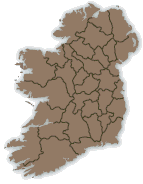Cú Chulainn - Tomás Ó Gallchobhair
Recording: [Download audio file]
[Download AIFF audio file (of processed ‘user’ version)]
[Download AIFF audio file (of archive version)]
Transcript
Nuair a d'fhág Cú Chulainn an baile thug sé fáinne dá bhean.
"Anois," a deir seisean, "nuair a líonfas mo mhac... nuair a líonfas a mhéar an fáinne cuir a fhad liomsa é."
Bhuel, nuair a chuir... líon a mhéar... a mhéar an fáinne chuir sí a fhad le Cú Chulainn an mac. Nuair a chonaic Cú Chulainn ag tarraingt air an mac chuir sé amach na fir ab fhearr bhí aige dá mhíotáil[1]. Nuair a... Bhí sé á gceangal agus á gcaitheamh 'na dhéidh ar an léana. Nuair a chonaic Cú Chulainn goidé a bhí a mhac a dhéanamh leis na fir chuaigh sé féin amach á mhíotáil, in araicis aige. D'fhiafraigh sé... Chuaigh an bheirt a throid. Nuair a... Mharaigh Cú Chulainn a mhac.
"Ó, Cú Chulainn, Chú Chulainn,
A athair is tú tollaithe,
(Ab é nach) d'aithin tú d'aonmhac
T'urchar fuar fann, agus an tsleag[2] in
aghaidh a hurla.
"Lig domh tuitim ar m'aghaidh, le heagla go ndéarfadh an Fhéinn go ndéanfainn teitheadh as teangmháil."
"Ó," arsa Cú Chulainn,
"Bheirimsa mo mhallacht do mhná an domhain
Agus do do mháthair féin go hiomlán,
A mhéad de mheangaíl atá ins na mná
D'fhág do lanntracha[3] dearg.
"Och, och agus mé ar mire
Ag goil suas malaidh Shliabh Buile,
Ceann mo mhic in mo láimh dheis,
A chuid airm agus éideadh insa lámh eile.
Ó, is ionann mac agus a bheith gan aon mhac,
An té a mbeadh aige an sé nó an seacht
Ní théanfaí[4] a chreach in éineacht."
Translation
When Cú Chulainn left home he gave his wife a ring.
"Now," he said, "when my son fills... when his finger fills the ring send him to me."
Well, when his finger filled the ring she sent the son to Cú Chulainn. When Cú Chulainn saw the son drawing near he sent out his best men to meet him. He tied them up and threw them on the lawn behind him. When Cú Chulainn saw what his son was doing to the men he went out himself to meet him, to confront him. The two began to fight. Cú Chulainn killed his son.
"Oh, Cú Chulainn, Cú Chulainn,
Father, when you were wounded (?),
Did you not (?) recognize your only son
Your cold weak shot, the spear pointing backwards (?).
Let me fall on my face, for fear that the warriors would say I fled the fight."
"Oh," said Cú Chulainn,
"I curse the women of the world
And your own mother entirely,
Such is the guile of women
That it has left your blades red.
"Alas, alas, and I am mad with rage
Climbing the slope of Sliabh Buile(?),
My son's head in my right hand,
His weaponry and clothing in the other hand.
Oh, having a son is like having no son at all,
He who had six or seven
Would not be brought down outright."
Footnotes
= mheetáil. Cf. Heinrich Wagner, Linguistic atlas and survey of Irish dialects (4 vols, Dublin, 1958-69), vol. 1, 291. (Back)= an tsleá/tsleagh. Cf. Úna Uí Bheirn, Cnuasach focal as Teileann (Dublin, 1989), s.v. sleag. (Back)
= lanna. Cf. Patrick S. Dinneen, Foclóir Gaedhilge agus Béarla (Dublin, 1927; repr. 1996), s.v. lann. (Back)
= dhéanfaí. Cf. Maeleachlainn Mac Cionaoith, Seanchas Rann na Feirste (Dublin, 2005), 178. (Back)
Commentary
This story is based on tradition surrounding the great Ulster Cycle hero Cú Chulainn, and describes an episode where he does not recognise his son, challenges him to combat, and kills him. He eventually realises who the youth is, and laments his actions. One of the earliest versions of the tale in Irish tradition is preserved in the Yellow Book of Lecan, and has been dated to the ninth century. The story persisted in written and oral tradition in Ireland and Scotland until the twentieth century at least. See Kuno Meyer, 'The death of Conla', Ériu 1 (1904), 113-21: 113. The central episode of the tale is categorised as an international folk motif, N731.2 Father-son combat, and has been recorded in many countries around the world. See Stith Thompson, Motif-index of folk literature (rev. and enlarged ed., 6 vols, Bloomington, Ind., 1955-8). A similar narrative appears in the great fourth-century Indian epic, Mahabharata, concerning the warriors Sohrab and Rustem, and other stories containing the motif have been recorded in Germany, Russia, Arabia, England and Persia. For a full discussion of the possible relationships between these versions, see Anna M. Ranero, 'That is what Scáthach did not teach me: "Aided Óenfir Aífe" and an episode from the "Mahabharata"', Proceedings of the Harvard Celtic Colloquium 16-17 (1996-7), 244-55.
A version of this story appears also in Seosamh Laoide, Cruach Chonaill (BÁC, 1913), 96-8.
Title in English: Cú Chulainn
Digital version published by: Doegen Records Web Project, Royal Irish Academy
Description of the Recording:
Speaker:
Tomás
Ó Gallchobhair from Co.
Donegal
Person who made the recording:
Karl Tempel
Organizer and administrator of the recording scheme: The Royal Irish Academy
In collaboration with: Lautabteilung, Preußische Staatsbibliothek (now Lautarchiv,
Humboldt-Universität zu Berlin)
Recorded on 03-10-1931 at 10:40:00 in
Courthouse, Letterkenny. Recorded on 03-10-1931 at 10:40:00 in
Courthouse, Letterkenny.
Archive recording (ID LA_1257d1, from a shellac disk stored at the
Royal Irish Academy) is 02:14 minutes
long. Archive recording (ID LA_1257d1, from a shellac disk stored at the
Royal Irish Academy) is 02:14 minutes
long.
Second archive recording (ID LA_1257b1, from a shellac disc stored in
Belfast) is 02:14 minutes long. Second archive recording (ID LA_1257b1, from a shellac disc stored in
Belfast) is 02:14 minutes long.
User recording (ID LA_1257d1, from a shellac disk stored at the Royal
Irish Academy) is 02:11 minutes long. User recording (ID LA_1257d1, from a shellac disk stored at the Royal
Irish Academy) is 02:11 minutes long.





